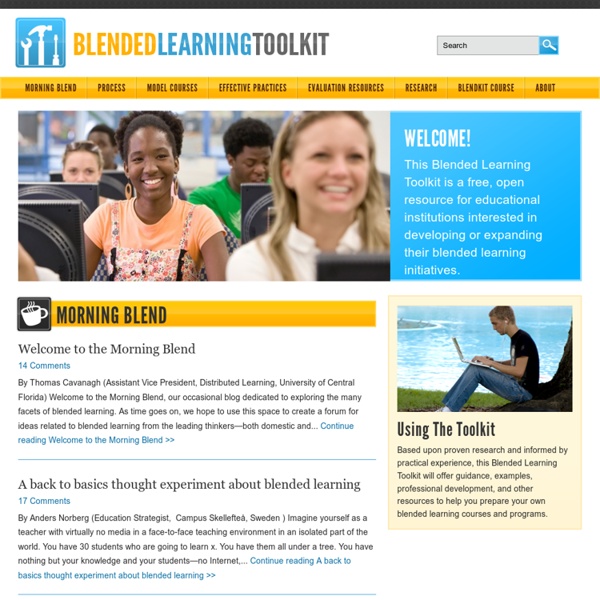How do students cope with self-paced blended learning?
The learning rates in a vanguard self-paced blended learning course have increased dramatically, and we think we know why A new school year. Students new to middle school from primary school. A new subject with a new pedagogy.
Effective Online Teaching
As I venture through my online teaching and course development I have been drawn to the question, what does an effective online teacher look like? If I am to develop a good online course then I will need to know what aspect I need to include in the course that would facilitate good online teaching practices. 1. Provide helpful resources on the course site: their summary indicated that “guiding questions helped students focus and develop their projects” (pg. 21)
10 Popular Blended Learning Resources Teachers Actually Use
by Janis Beem Whether you’re new to blended learning or a seasoned veteran of blended learning, there’s always more to learn. Take a look at 10 of the top resources for blended education, also known as hybrid learning, from some of the most notable names in the field. So, in addition to great resources like YouTube, iTunesU, and a variety of blogs and social media channels, here are 10 of the most popular blended learning resources teachers use.
edutopia
P.K. Yonge views blended learning as the combination of digital content and activity with face-to-face content and activity. It looks very different in each class at the school. When a teacher has an activity that works well face-to-face, there isn't any reason to look for a digital replacement. If they can find something digital that is more effective or efficient, then that is implemented.
How to Successfully Implement a Blended Learning Program
No educational technology topics were off limits, and for good reason, during last week’s NCTies. Everything from identity management to flipping the classroom was fair game, and with the state’s NCEdCloud initiative still somewhat of a mystery, there’s a lot of change going on in the Tar Heel State. One session that caught the attention of many educators during the day-and-a-half long event was on blended learning in the elementary school classroom. Rebecca Phillips and Emily Schmidt from Coltrane Webb STEM Elementary guided a crowded room of teachers on how to successfully implement a blended learning program.
The Key To Learning: Knowing How Learning Works
What’s the key to effective learning? One intriguing body of research suggests a rather riddle-like answer: It’s not just what you know. It’s what you know about what you know. To put it in more straightforward terms, anytime a student learns, he or she has to bring in two kinds of prior knowledge: knowledge about the subject at hand (say, mathematics or history) and knowledge about how learning works. Parents and educators are pretty good at imparting the first kind of knowledge. We’re comfortable talking about concrete information: names, dates, numbers, facts.
Blended Learning: Strategies for Engagement
There are methods and models for implementing blended learning -- from the flipped classroom, to the flex model. All of them are on the continuum of just how much time is spent online and in the online classroom. Blended Learning can provide a unique way of not only engaging students in collaborative work and projects, but also personalizing and individualizing instruction for students. However, there is still one piece that is missing from a great blended learning environment: engagement! As an experienced online teacher of both K-12 and higher education students, I am familiar with the challenges of engaging students in virtual work. Luckily, the blended learning model still demands some in-person, brick-and-mortar learning, so there is a unique opportunity to use this structure to engage students.
Self-paced blended learning highlights ‘average’ student myth
By Peter West Read more by Contributor March 18th, 2014 Data from a middle school self-paced blended learning class reinforces the concept that variation from one student to the next is significant “If you design something for the average …person, wouldn’t it fit most people?” Todd Rose – The Myth of Average: from TEDx This seems like a natural conclusion to draw, but research has shown this is incorrect.
7 Must-Have Tools For The Flipped Classroom
7 Must-Have Tools For The Flipped Classroom by first appeared on gettingsmart.com The flipped classroom uses technology to allow students more time to apply knowledge and teachers more time for hands-on education. It’s a continually changing strategy that evolves with technology. Innovative educators are usually on the lookout for the latest technology breakthroughs that will help them better organize and conduct flipped classrooms. The following tools are listed from most basic to most sophisticated and can be used alone or in tandem to make flipped classrooms more engaging. Google Drive


